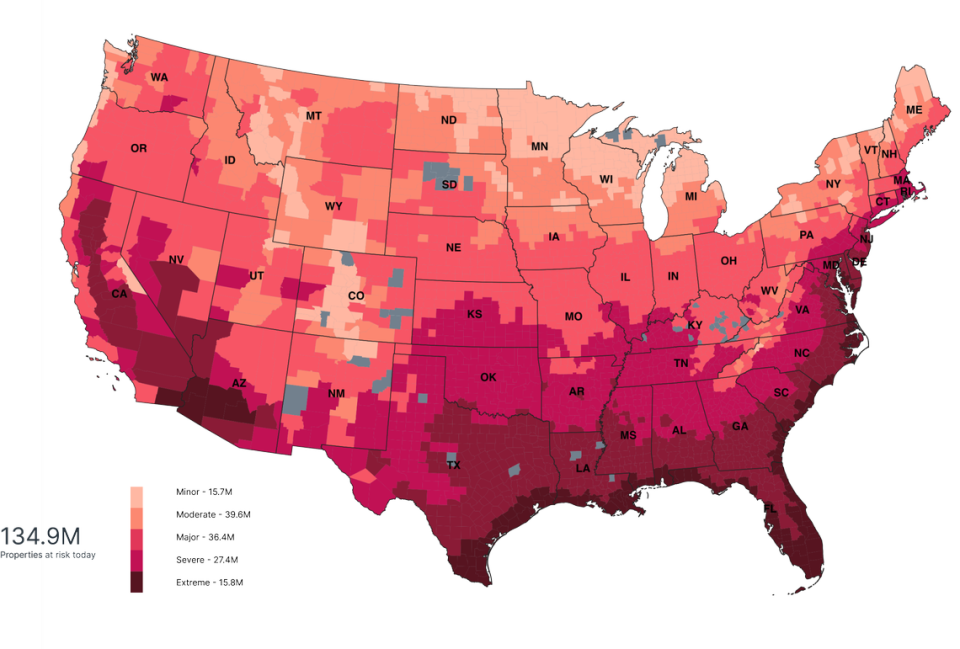Kansas City summers could be as hot as 125 degrees in the next 30 years, study finds
A zone of extreme heat will develop in the U.S. over the next 30 years, and Kansas City is expected to feel some of its worst effects, a new study from the nonprofit data analysis group First Street Foundation found Monday.
The study described an “extreme heat belt” of U.S. counties that will experience at least one day per year with a heat index of 125° F by 2053. A heat index is the temperature the air feels like due to actual temperature and humidity combined.
“We need to be prepared for the inevitable, that a quarter of the country will soon fall inside the Extreme Heat Belt with temperatures exceeding 125°F and the results will be dire,” said Matthew Eby, founder and CEO of First Street Foundation, in a Monday press release.

What does the study measure?
The study analyzes surface air temperatures down to the property level—much more specific than many other climate studies—in order to estimate the temperatures residents will feel over time. These temperatures, combined with humidity levels, give the ‘heat index’ temperatures that correspond to how hot the air feels when you step outside.
These temperatures were then adjusted based on predicted greenhouse gas emissions over the next 30 years. The results showed how many days out of the year a given area is likely to experience extremely high temperatures.
How will this ‘extreme heat belt’ affect Kansas City?
All the counties in the Kansas City metro area fall into the zone that will experience at least one 125 degrees day by 2053, as do counties across the Midwest as far north as southern Minnesota.
“The central and Midwestern regions of the country face the highest probabilities of experiencing Extreme Danger Days, or days exceeding a 125°F heat index,” the study found.
The study reports that these ultra-hot days can cause a variety of life-threatening conditions like heat stroke. It also lists Kansas City as one of the top five metropolitan areas likely to be impacted by these dangerous conditions based on the number of neighborhoods affected.
In both Kansas and Missouri, the hottest temperatures of the year will both become hotter over time and will last longer, the study shows. That means that heat waves like the ones we saw this summer will become longer and more frequent over the next 30 years.
What is causing this temperature rise?
The ongoing climate crisis is fueling the rise in temperatures around the world. Greenhouse gas emissions from industries like petroleum and manufacturing trap the sun’s heat inside the Earth’s atmosphere, causing sea level rise, changes in weather patterns, mass species extinctions and the heat this study describes.
The Midwest is particularly susceptible to these temperature increases due to its location, the study states. The “Extreme Heat Belt” that covers much of the Midwest consists of “areas relatively distant from the ocean which generally do not benefit from the coastal breezes that help to keep the Southwest, Southeast, and East Coast from hitting these extreme temperatures.”
While the rising temperatures described in this study are largely caused by greenhouse gasses, they will likely result in the production of more greenhouse gasses as well because of increased use of electricity for air conditioning.
Missouri is anticipated to be the state with the fifth-largest increase in CO2 emissions due to this scorching weather. The study estimated that the state will produce nearly 891 million more pounds of CO2 from air conditioning alone if current emissions levels from electricity consumption hold steady.
While the city is working on a plan to reduce emissions through a transition towards clean energy, the increased demand for air conditioning in the coming decades may strain the city’s power grid. The study projected that this cooling will cost residents a combined $69.5 million more than what they spend now.
Do you have more questions about the impacts of climate change in Kansas City? Ask the Service Journalism team at kcq@kcstar.com.

